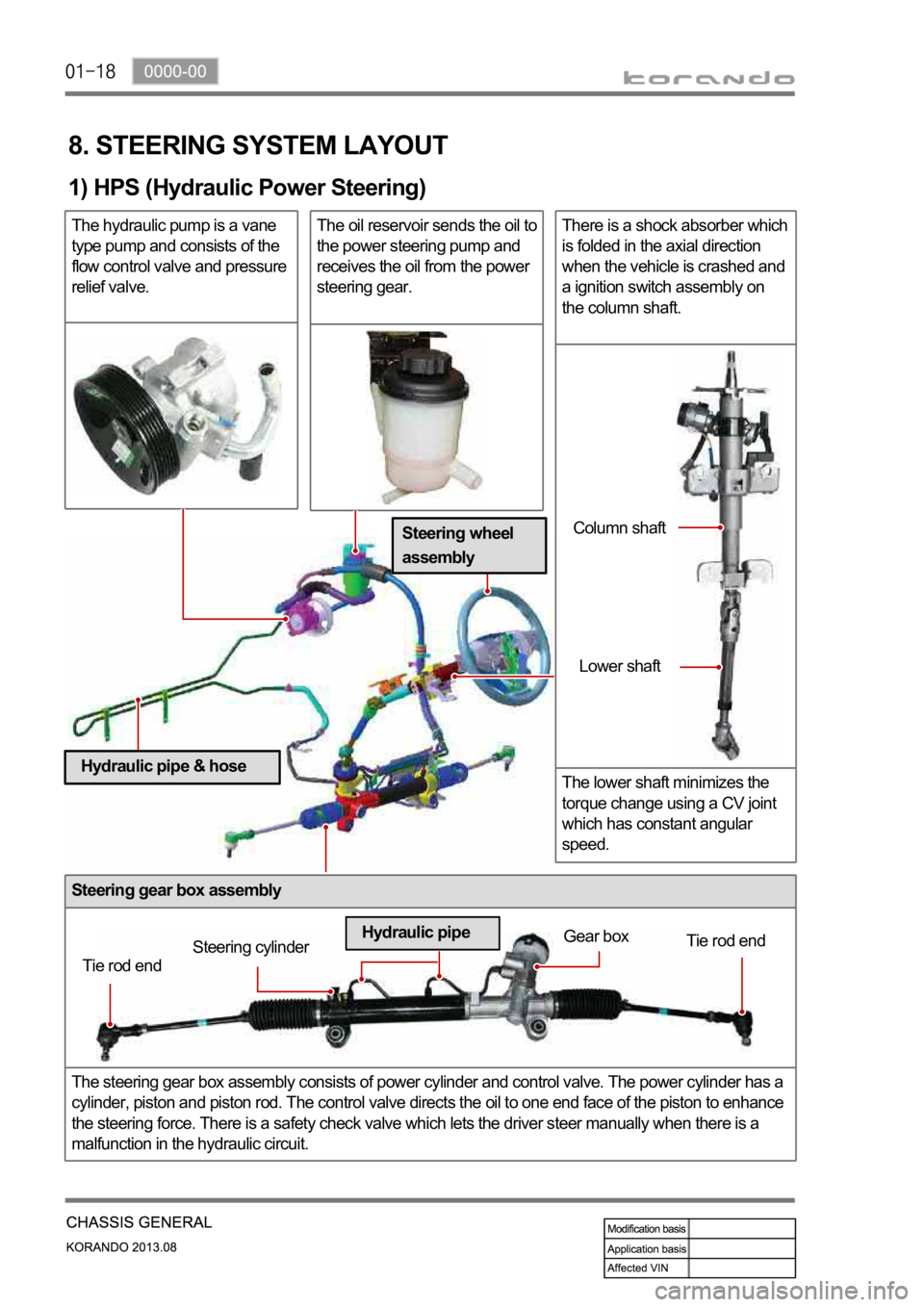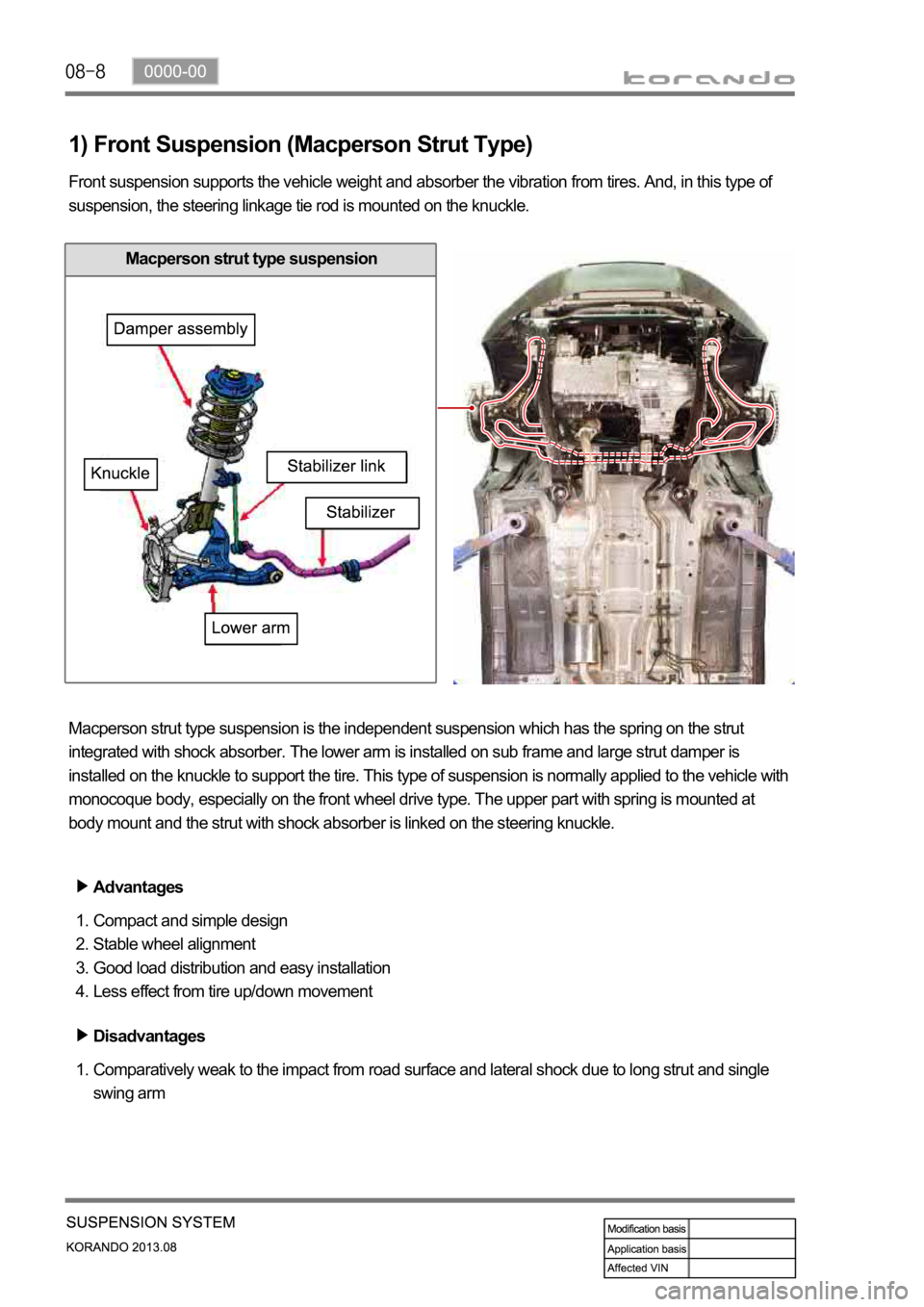Page 996 of 1336

Steering gear box assembly
The steering gear box assembly consists of power cylinder and control valve. The power cylinder has a
cylinder, piston and piston rod. The control valve directs the oil to one end face of the piston to enhance
the steering force. There is a safety check valve which lets the driver steer manually when there is a
malfunction in the hydraulic circuit.
8. STEERING SYSTEM LAYOUT
1) HPS (Hydraulic Power Steering)
The hydraulic pump is a vane
type pump and consists of the
flow control valve and pressure
relief valve.The oil reservoir sends the oil to
the power steering pump and
receives the oil from the power
steering gear.There is a shock absorber which
is folded in the axial direction
when the vehicle is crashed and
a ignition switch assembly on
the column shaft.
The lower shaft minimizes the
torque change using a CV joint
which has constant angular
speed.
Tie rod endSteering cylinderGear box
Tie rod end
Hydraulic pipeColumn shaft
Lower shaft
Steering wheel
assembly
Hydraulic pipe & hose
Page 1072 of 1336
1. OVERVIEW
The propeller shaft is a thin steel pipe which transfers the power from the transmission to the E-coupling,
and has high resistance to torsion and bending.
The propeller shaft has the universal joint (cross axle) mounted on the center of the shaft and splines for
the slip joint on the E-coupling side to accommodate the height and length changes which occur as the
shaft rotates at high speed.
And the rubber bushing for center bearing in the center of the propeller shaft keeps the balance of the
shaft and absorbs its vibration.
Function of propeller shaft
Transmits driving torque.
Accommodates the angle change (universal joint / CV joint).
Accommodates the axial length change (splines for the slip joint). -
-
-
CV joint
Universal yoke and
center bearingUniversal yoke and
rubber coupling
Page 1073 of 1336
3310-02
2. COMPONENT
1 End cap 18 Plain washer
2 VL joint assembly 19 AL washer
3 Washer 20 Center bearing assembly
4 Bolt 21 Ball bearing
5 Circlip 22 Dust shield
6 Clamp (big) 23 Intermediate shaft
7 Boot 24 Fork yoke
8 Clamp (small) 25 Rubber coupling
9 Stub shaft 26 Alignment support
10 Bending absorber 27 Bolt
11 Paper damper 28 Washer
12 Tube yoke 29 Lock nut
13 Oil seal 30 Balance weight
14 Spider 31 Protecter
15 Bearing cap 32 Tube
16 Intermediate yoke 33 Tube
17 Bolt 34 Bending absorber
Do not remove the rubber coupling since the vibration balance could be improper once removed it.
Page 1078 of 1336
0000-00
System Description Specification
Front
suspensionSuspension type Macperson strut type
Spring type Coil spring
Stabilizer type Torsion bar type
Shock absorber Type Cylindrical reciprocation type
Max. length (extended)
564 mm
Min. length
(compressed)372 mm
Min. length
(compressed)Inner diameter (A) Upper: 84.0 mm
Lower: 100.0 mm
Outer diameter (B) 163.1 mm
Free length (C) 356.1 mm
Installed length (D) 276.0 mm
Coil windings 5.32 turns
Winding direction Right direction
Rear
suspensionDriving type AWD 2WD
Suspension type (trailing, upper, lower & track
rod)Multi-link type
Spring type Coil spring
Stabilizer type Torsion bar type
Shock absorber Type Cylindrical
reciprocation type
Max. length (extended) 551 mm
Min. length
(compressed)361 mm
Coil spring Diameter (A) 12.8 mm 12.6 mm
Free length (B) 287.1 mm 291.7 mm
Coil windings 6.64 turns 6.32
Winding direction Right direction
1. SPECIFICATION
Page 1082 of 1336
0000-00
1. OVERVIEW
The suspension is the device to connect the axle and vehicle. It absorbs the vibrations and impacts from
road surface, which enhances the comforts, driving force, braking force and drivability.
Underview of vehicle with 2WD, 6M/T Underview of vehicle with 4WD, 6A/T
Front suspension
Rear suspensionFront suspension
Rear suspension
Page 1083 of 1336

1) Front Suspension (Macperson Strut Type)
Front suspension supports the vehicle weight and absorber the vibration from tires. And, in this type of
suspension, the steering linkage tie rod is mounted on the knuckle.
Macperson strut type suspension is the independent suspension which has the spring on the strut
integrated with shock absorber. The lower arm is installed on sub frame and large strut damper is
installed on the knuckle to support the tire. This type of suspension is normally applied to the vehicle with
monocoque body, especially on the front wheel drive type. The upper part with spring is mounted at
body mount and the strut with shock absorber is linked on the steering knuckle.
Advantages
Compact and simple design
Stable wheel alignment
Good load distribution and easy installation
Less effect from tire up/down movement 1.
2.
3.
4.
Disadvantages
Comparatively weak to the impact from road surface and lateral shock due to long strut and single
swing arm 1.
Macperson strut type suspension
Page 1087 of 1336
0000-00
2. SYSTEM LAYOUT
1) Components
(1) PTU (Power Transfer Unit)
and transfer it to E-coupling to distribute the torque to rear wheels.
(2) E-Coupling (Electronic Coupling)
E-Coupling transfer the engine torque from PTU to rear axle and controls to distribute it between front
wheels and rear wheels.
(3) E-Coupling Control Unit (ECU)
E-Coupling controls the current (clutch engagement force) of EMCD in E-Coupling according to CAN
signals (wheel speed, engine torque, pedal position, ABS/ESP signals).
* EMCD: Electro-Magnetic Control Device PTU assemblyE-coupling control unit
(located on the floor under driver seat)E-coupling
Page 1088 of 1336
4850-00
1. SYSTEM OVERVIEW
1) Terms and Definition
CBS: Conventional Brake System
ABS: Anti-Lock Brake System
EBD: Electronic brake-Force Distribution
ESP: Electronic Stability Program
ABD: Automatic Braking Differential
ASR: Acceleration Slip Regulation
AYC: Active Yaw Control (Understeer and Oversteer Control)
HBA: Hydraulic Brake Assistant
ARP: Active Rollover Protection
HSA: Hill Start Assistant -
-
-
-
-
-
-
-
-
-
2) Functions
FunctionVehicle with CBS
Vehicle with ABS/EBD Vehicle with ESP
ABS
Not appliedApplied
Applied EBD Applied
ABD
Not applied ASR
AYC
HBA
ARP
HSA